Iron-on embroidery design transfers fall into a love-hate category for me.
I love the idea of being able to iron an embroidery design straight onto a piece of fabric, without having to go through the rigmarole of transferring an embroidery design in various, nefarious, laborious ways.
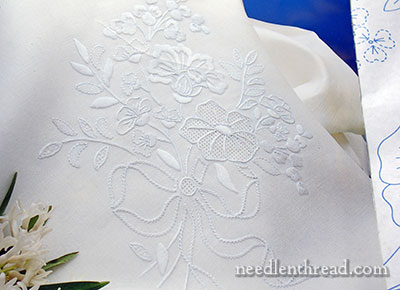
And yet, and yet… when it comes to iron-on designs, I generally don’t like the selections widely available today.
Oh, don’t get me wrong! They’re fun for quick projects. I use many of the vintage-look iron-ons, Aunt Martha iron-ons, Sublime Stitching iron-ons, and the like especially when I’m setting up projects for kids to learn on, or when I’m stitching up something quick and fun as a gift for a specific person.
But, to be blunt about it, the majority of iron-on transfers available today can’t really be taken seriously for embroidery. Space men, pin-up girls, bleeding hearts, goofy looking birds, flower-power blossoms – these are not designs you’d be putting quality time and quality materials into, to create a family heirloom that, ten or twenty years from now, will still be admired and appreciated for its beauty, art, skill, style.
These fun, fad designs serve a purpose – they make embroidery fun. They make embroidery trendy. And they attract a new generation of embroiderers. So, in that regard, they’re great.
But for those looking for the ease of an iron-on transfer with a little sophistication in design, they don’t usually fill the bill.
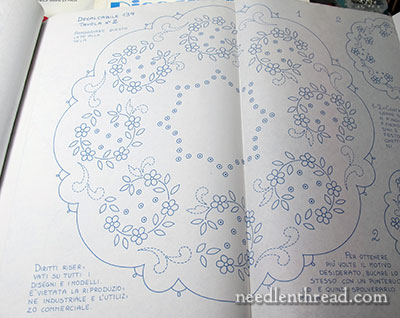
Do such iron-ons still exist? They do! You just have to know where to find them. And since I’ve had this very question come into the inbox several times in the last few weeks (in essence: where can I find iron-on transfers that are not cartoony?), I thought I’d talk about the subject a little bit.
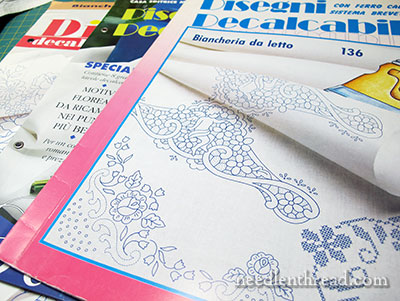
If you’re looking for embroidery design transfers that are not quite as cartoony as the popular transfers on the market today, you have to look towards Europe to find them.
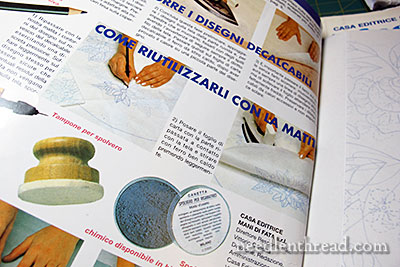
And most abundantly, you’ll find them produced in Italy. This means that the instructions in the book are in Italian, but they are profusely illustrated with photos, so that you can see how to use the transfers with an iron or with other methods, like tracing or prick-and-pounce.
Here in the States, you can find these imported transfers available through Lacis, in California. Use the search feature and type in “Mani di Fata” for a good list of Italian iron-on transfers available for all kinds of embroidery techniques, or you can type in “transfer” for other iron-on designs that are not specifically produced by Mani di Fata. You’ll have to browse through several pages, but it’s worth the browse.
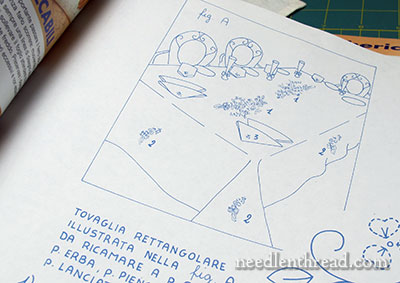
Besides the designs themselves, most of the transfers that focus on household decorative items will include clear instructions for laying out the designs on table linens, bed linens, kitchen towels, and the like.
So, if you’re looking for iron-on transfers for hand embroidery – if you’re held back from embroidery because you just can’t stand the transfer process – then you might look into some of the iron-on transfer packets and books available at Lacis.
If you’re looking for the cutesy-vintage iron-on transfers available today or some of the more trendy embroidery designs – especially if you’re trying to attract youth into the world of surface embroidery – try Aunt Martha’s iron-ons (google them – you can find them through all kinds of craft stores, chain stores, hobby stores, and the like), Colonial Patterns, and Sublime Stitching.







Dear Mary
I’ve not tried iron-on transfers but the transfers above are really pretty, it’s a shame that vintage iron-on transfers are not more widely available as this is an easier option then drawing on or using the prick and pounce method. Thanks for sharing the links to iron-on transfers at least we now know where they are available.
Regards Anita Simmance
I love the Aunt Martha’s, and Vogart and other vintage embroidery transfers, because most of them are intended to be fast, fun, and used. Or in the case of kitchen towels, abused :-/ . But you’re right, thinking of doing them in silks and goldwork just don’t cross my mind.
Regarding transfering patterns, it occured to me this weekend that I have one of those projectors that you slip a photo or drawing under and it’s projected on the wall. And depending on how close or far you move the projector to the wall, automatic resizing! Although it might take some care to keep sections lined up and same size, if the original is bigger than what the projector can handle.
For small, quick projects you could place your fabric in a frame over your ipad or android device, with the image you want to copy (e.g. the webpage with Mary’s lovely free designs), scaled to the size you need, and trace. The screen is bright to enough to make the image visible through fabrics that are not too dense. You can copy images that are larger than your screen by scrolling about, but you probably need some grid reference.
I see iron-on pamphlets now and then at the thrift shop. I bought an older booklet a few years ago by Celia Totus. It’s from 1989. Not exactly antique but I had this urge to rescue it. LOL It’s just complicated florals that I’ll probably never stitch but I enjoy looking at them.
I wonder how long the transfer ink on these will last.
I agree that the Aunt Martha patterns aren’t too exciting but I have a few of those too. Good for kitchen towels and pillow cases.
Thanks Mary! I love Sublime Stitching, and you are right — it is very hard to find decent iron-on (embroidery!) transfers. Thanks for the tips and links.
The Mani di Fati transfers are lovely! And how could one not want something from “fairies’ hands”!
Another source for some non-cartoony transfers is Dover Publishing. They are available from their own website or through most online booksellers. Here’s an example at amazon: http://www.amazon.com/American-Wildflower-Iron-Transfer-Patterns/dp/0486256243/ref=pd_sim_b_6
I just came across some State Bird blocks I embroidered in High School using some iron on transfers. I have to make something out of them although I didn’t finish all the states and I think I tossed the set of iron on’s out so I can’t finish them. All I can think of making is a quilt but not too enthused about it. I prefer tracing with my light box. It seems to me I’m always drawn to embroidery, crochet, knitting items just to find out the instructions are in a foreign language. They have some awesome designers overseas. There are so few people in the states like you Mary….talented and willing to share your talent with others, or I haven’t discovered them yet. So thankful you are here.
I agree with you about the cartoony, kitschy nature of some modern embroidery transfers. I taught embroidery at the local senior center, so my projects had to be simple, but appealing. I found the Dover transfers to be very pretty, and I also found some at Patternbee.com.
Hi Mary!
Another resource for iron-on transfers is from Dover Publications. I’ve used transfers from them several times. I’ve gotten William Morris designs, Celtic designs and a lot of other ones from them. Anyway it’s just another option.
-Heather S.
There are so many blogs these days that have instructions on transferring images to various materials, including cloth, couldn’t you find an alternate method using whatever picture you could print on your home computer? The Graphics Fairy, for instance, has how to instructions for transfers, along with plenty of images. Then, too, there are the computer-aided electronic cutters, like Silhouette. Maybe you could come up with a traceable pattern with one of those. Just tossing out ideas; haven’t tried any of these yet.
Dear Mary,
Thank you for taking me away to sunny Italy on this getting-ready-for-miserable-weather day on the mountaintop. I enjoy the old iron-on transfers and embroidering them with more fanciful stitches than stem, daisy and french knots. Your nod to Italian designs led me to http://www.manidifata.it. They have their share of novelty designs but the cafe curtains with shadow embroidery, cutwork and other techniques have me hurrying to finish the wooly hot water bottle covers I’m decorating for a birthday present. The lovely translucent curtains speak of sunshine, starch, cool breezes and luminous vistas.
Thanks for sharing the sites where iron on transfers are available. It’s wonderful to have a source for them.
There are also pencils with which you can trace any design that you like on paper, flip it around and use it just as you would any iron-on transfer. I found that you can actually use them several times if you want. I don’t know which ones are good in the US but if you search for “iron on pencil” on amazon you get quite some hits.
G’day Mary,
Pleased to have this info. Way-back-when it was all we knew to use, as well as stamped items. Thanks, Cheers, Kath
Thanks Mary! And to all the others with recommendations : )
Ive been looking around at the local stores for some quality designs/iron ons and been disappointed. The complex designs with lots of little lines I love but theyre so hard to trace!! Ive tried copying a few but they never turn out even…. which is very noticable in mirror designs.
Has anyone heard of the sulky stablizer/transfer? I saw it on another blog. You can either trace on it or run it through a printer, the back peels off and you stick it on top of the enbroidery. It comes off in warm water and doesnt peel off as you stich. Anyone tried or heard of this item??? I was thinking of using it for regular floss projects…
I am looking for my mother-in-law, who likes to needlework, but is not really good at it being 85 yrs. young. She has a grand daughter that is getting married in April and would like to embroider their names on a pillowcase. Can you guide me in the direction that would help me locate what we need.
Hi,
I am wanting to make a wildflower lampshade, but cannot find a wildflower transfer sheet. As I want to lay the whole design out before I start to embroider, which will all be in black, I need to lay out the design, this will be easier with transfers. I am particularly interested in cow parsley with the beautiful umbels for height, and smaller plants for ground level. Can you help me please.
Yours in friendship,
Chris Wells.
Hi, Chris – I’m not sure where to find transfers for these specific flowers. Maybe you could look up clip art for the various foliage you want to use, and then trace them? That might work!
I am seeking iron on transfers for quilting the quilt I am making. But all my searches come out patterns for cutting custom blocks for the top. I just want a simple easy transfer for free quilting the project that can be followed with a sewing machine! It is nearly impossible.
Thank you so much for this information. I have been searching for just this info. as I have just started on my granddaughters hope chest . I can’t wait. LOL I have about 10 years so I better get started. Thanks ever so much
A friend found quilt blocks that had been stamped many years ago. They were of the state birds and flowers. She then embroidered them but when she tried to wash out the marks they did not disappear. Do you have any suggestions as to why and or how to remove these marks from the blocks? Thanks for any help you may have.
Often, pre-transferred / stamped designs don’t wash out. They may fade over time, but it really depends on how they were manufactured and the transfer material used. That said, you could try a little alcohol on the end of a q-tip and see if that helps. Be careful, though, that you don’t come into contact with threads that might not be colorfast. But my guess is, they won’t wash out. Normally, with stamped linens – especially some of the old ones – they are permanent, and the embroiderer would cover the lines completely while stitching them.
Hello and good evening my name is Adrienne Mccambry and I would like to be added to your e-mail list.
Hi, Adrienne – Thanks for stopping by Needle ‘n Thread! You can subscribe to the website by visiting the home page: http://www.needlenthread.com and scrolling down the left column. You’ll see the email subscription form there. If you’re on a mobile device, just click the top menu on the right (the three little lines) and you’ll get a menu to scroll down, and you’ll find the subscription form underneath the about section. Thanks! 🙂
I hope you will see this and have a moment to help me! I have just decided to get into embroidery and am very excited about it and trying to learn everything. I have a pattern that I printed that says “Reversed pattern for iron-on transferring.” How do I use this as an iron-on transfer? I am trying to avoid tracing, because with the last pattern I traced the fabric kept moving and the drawing did not come out very well. Thank you so much for the sources for non-cartooney patterns!
If you want to make a pattern into an iron-on, you’d need to at least trace it with an iron on transfer pen. I like the fine-tipped iron-on transfer pens from Sublime Stitching. They’re good!
Ok, thank you.
I want to learn how to do it myself… But I will look at the website provided… And I thank you for this… I love to embroidery….